How much should your firm pay for IT support in 2020?
Plus tips for spotting inflated IT support bills
A funny thing happened on the way to the cloud – IT got a hell of a lot better and much cheaper. Servers and software crashed less often, desktops too, and not just because the software was now running in a browser rather than the local hard drive. Operating systems and hardware have become much more reliable.
Paying less money for better resources should be cause for celebration for any business. But it begs the question – if technology is more reliable, why haven’t IT support bills reduced in price as well? After all, we don’t need to call up a server technician as often as we used to 10 years ago.
It is understandable why so few firms are asking themselves how much they should pay for their IT support. IT functions as a black box that is critical to business, so firms just pay their bills without murmur or complaint.
But once you stop and look at what’s on the bill, you will start to wonder where your hard-won profits are going.
How to spot an inflated IT bill

IT support bills are well known for gradually creeping up in a way that is almost impossible for a non-technical person to identify. The net result; your IT bill rises every year, backed by reasonable sounding justifications, until it is a hell of a lot more than what you were paying five years ago. Or, just as likely, your IT bill has stayed the same for the past five years while the amount of support you require has dropped dramatically.
There are a number of tricks to inflating an IT support bill. Here are the classics.
#1 – How much is that server in the (browser) window?

Pop quiz – how much should you spend on a server for a 20-staff firm? Are you thinking around 10k or closer to 30k? Traditional IT support companies often insist that your practice software is so complex that it needs an expensive server that won’t grind to a halt in the middle of tax season.
The reality is that firms around the world overpay for heavy-duty servers capable of running the needs of three firms simultaneously. Instead, they idle quietly in the corner and never once break a sweat before their retirement.
The next time you’re up for a server refresh and you hear this from your IT support company – “You get what you pay for so don’t compromise by running on low grade hardware” – ask for a second opinion from another supplier. Otherwise you can literally pay 200% more for a machine to run practice management than every other firm.
One firm was recently told it needed a $25,000 server – and discovered it could run its practice management software on a very fast server for under $8,000.
#2 – The Maze of Microsoft 365

Microsoft has one of the most complicated licensing schemes in the business, with multiple options at every level for personal, small business and enterprise, and any number of upsells.
This is because Microsoft works with everyone from sole traders to the biggest companies in the world and needs plans to match.
This plethora of choices is a maze to navigate for a small business and they can easily be led down the wrong track.
When Microsoft Exchange Email migrated to the cloud, the licensing was usually handled by the same IT professional managing your server. They will typically recommend one of the plans to the firm that will give them the same features they enjoyed on the server. But there is huge scope for upselling to unnecessarily expensive plans.
For example, the average accounting firm will be well served by Microsoft 365 Business Standard, which costs $17.20 per user per month. (Microsoft rebranded Office 365 as Microsoft 365.)
If you’re on Business Premium ($27.50 per user per month), E3 ($46.40 per user per month) or E5 ($78.30 per user per month), you’re likely paying for features that you’re never going to use. And if you’re paying more than $17.20 a month for Business Standard, then the IT support guy is taking a clip – but doing nothing to justify that charge.
It’s worth making the effort to double check your bill, even just to check the number of licences.,One Australian firm with 15 staff realised that its IT support company had been charging it for 30 licences at $34.80 each – twice the number of licences it needed, and sold at a 100% markup!
#3 – Extras, Extras, Extras
Businesses are used to paying for software on a monthly basis, either month to month or on an annual contract. Yet there are still IT support companies that insist on bundling services and locking customers into a three-year contract.
They are often reluctant to explain the line items and why they are worth paying for, usually because they have unnecessary markups.
For example:
- Domain hosting costs as little as $20 a month but has been oncharged at $90 a month. There is no value add here from the IT company outside of management which should be covered in regular services fees, it’s pure profit.
- Internet connections mysteriously attract extra fees to increase bandwidth or for unlimited data. Market competition driven by the NBN has slashed the cost of high-speed broadband. Those extra fees don’t make the bits move any faster.
- Networking is another black box. Everyone hates it when the network goes down so you’re not going to question anything that will keep it up. Except, perhaps, fees for “router rental”, “router service” and “managed firewall”. A router/firewall with advanced features and security for a SME network costs a few hundred dollars new. After initial config, ‘management’ includes making very occasional changes or attending to almost never alerts.
Another Australian firm had all sorts of creative additions that pushed up its final bill to 35% higher than it should have been.
Why Firms Overpay for an Outdated Business Model

As you can see, there are plenty of ways to increase an IT bill. However, the size of your bill is also driven by the business model of your IT services provider.
Consider your IT setup 10 years ago. A hosted server was probably the centre of your productivity universe. It ran your emails (Microsoft Exchange), stored your documents and other files, including the accounting files for all your clients. It also ran your practice management suite, the beating heart of your practice. Plus other important line-of-business tools such as SMSF.
What does your practice look like today? The likelihood is that most if not all of those tasks are run from the cloud – on massive servers in some gargantuan data centre somewhere on the internet. In some cases, all that’s left for your server to do is store legacy data and run Active Directory, a Microsoft program that controls access to various resources on your network.
In fact, some firms have flicked their server completely, or if they are less than a couple of years old, they have never had to buy one in the first place.
All this points to the shrinking role and relative importance of the server within accounting firms. If the server went down a decade ago this was indeed very bad for a firm. These days, your staff can probably keep working in client files, receive and send emails and otherwise perform their jobs without too much impact.
The problem is that most IT support companies still treat the server as a critical piece of infrastructure for which customers must pay a premium to keep operational. And for IT support companies with customers across a broad range of industries, this could generally still be true. Architectural and engineering firms haven’t moved to the cloud as fast as accountants. This is partly because their client files can be so large that pushing them around the internet just isn’t feasible. The server still retains a central role in the operation of their businesses.
IT support companies don’t just charge a premium to look after your underused server. They also need to hire more server technicians. Even though you’ll probably never need them, other customers might.
The mindset of the support company is also focused on managing complexity. Server-heavy operational models require a lot of on-premise components to keep the business operating, such as redundant systems and on-premise backups.
Old model IT providers wrongly categorise similar sized accounting firms as businesses that also require complexity. But most accounting firms with 100 staff or fewer don’t have the same needs. They need a simple, cost-effective framework that helps them get the job done.
So this is the disconnect that accounting firms face when it comes to paying for IT support. Traditional model IT support companies look after the crown jewels – the line of business software – which used to sit on the server. Accordingly, they charge a premium to guarantee maximum uptime of that server.
Now, most of the important software for accounting firms is run in the cloud. Cloud-based software companies include uptime as part of their business model. And yet many IT providers are still charging like they’re looking after the crown jewels.
In short, if you haven’t reviewed your IT contract in the past 10 years, you’re paying a premium that you just don’t need.
The Cost of a Pre-Modern Mindset
It is pretty easy to get some competitor quotes and work out if you’re paying more than you should for your IT support services. It’s a little harder to work out if you’re getting value for what you’re paying for.
One of the best ways to work out value is to look at the impact of IT issues within your firm today.
- Office noise: Are your staff complaining to partners about printers not working or flaky internet connections?
- Slow response times: Do your staff have to wait for hours or the next day to get someone to respond to a tech problem?
- Reactive advice: Do you have to come up with the next stage in your IT strategy and chase your IT support company for feedback?
If you’re experiencing these issues, then you’re not getting value for your IT support. The reason why is again due to the business model rather than the quality of staff. Traditional IT support companies working with customers in many industries need to prioritise by urgency of the issue. If an engineering firm’s server crashes, then it’s all hands on deck until the firm is back up and running again.
Unfortunately this means that companies with less urgent issues need to wait at the back of the queue. A tech issue may be less urgent in that it affects one person and not the whole office. However, it is still stopping one person from completing their job, billing a client and generating revenue.
It’s a similar story at a strategic level. Generalist IT support companies are very good at managing the risk of business continuity in complex IT environments. However, they tend to have little experience or interest in helping create workflow-based strategies based on cloud software.
The accounting profession has a smorgasbord of technology options when it comes to improving efficiency, adding new service lines and automating tasks. This is where the most value is for accounting firms – in knowing how to best use the latest software, not how to build the most robust hardware platform.
The result of this ‘stretching’ between industry modernisation and platform complexity is creating a scenario where accounting firms are unable to gain the workflow efficiency and other benefits that these very apps were purchased to provide.
Everything Is Better—Apart From The Service

Stop for a second and think back to your first mobile phone. Compare it in your mind to the slick, handheld computers we use to entertain ourselves and communicate with others today. It feels like an age ago, even though it was just 13 years since the launch of the iPhone.
Business software has followed a similar path, if at a slightly lower trajectory. The clunkiness of managing PST files and rebooting your Exchange Server has given way to online email that is far more reliable.
Searching through deep nested folders for documents on your server has been replaced by friendlier interfaces such as HowNow X, SuiteFiles and FYI Docs.
And Windows 10 is a hundred times better than Windows XP.
Technology may still frustrate us from time to time. But it has slowly improved to the point where it’s remarkably better than 2010. Phrases such as “Blue screen of death” have passed into history; there will be staff in your office who won’t even know what that means.
Just as technology has modernised, so should the service that supports it. You don’t need a team of hardware technicians to fix your problems today.
Firms need proactive support that identifies issues before they arise, a customer service team that responds to requests quickly and effectively, and a partner who can help you create a strategy to achieve greater productivity.
Take 15 minutes to print out your IT services bill and review how much you’re paying and what you’re paying for. Then get some quotes from IT companies that specialise in your industry.
You may discover that you can get higher quality service at a much better price.
If you want to learn how Freshmethod can help you reduce your IT costs and optimise your technology, click here to book a call with one of our consultants.

